Policymakers in both the U.S. and Europe are undertaking increasingly brazen acts of escalation in Ukraine designed to bring Russia to the breaking point.
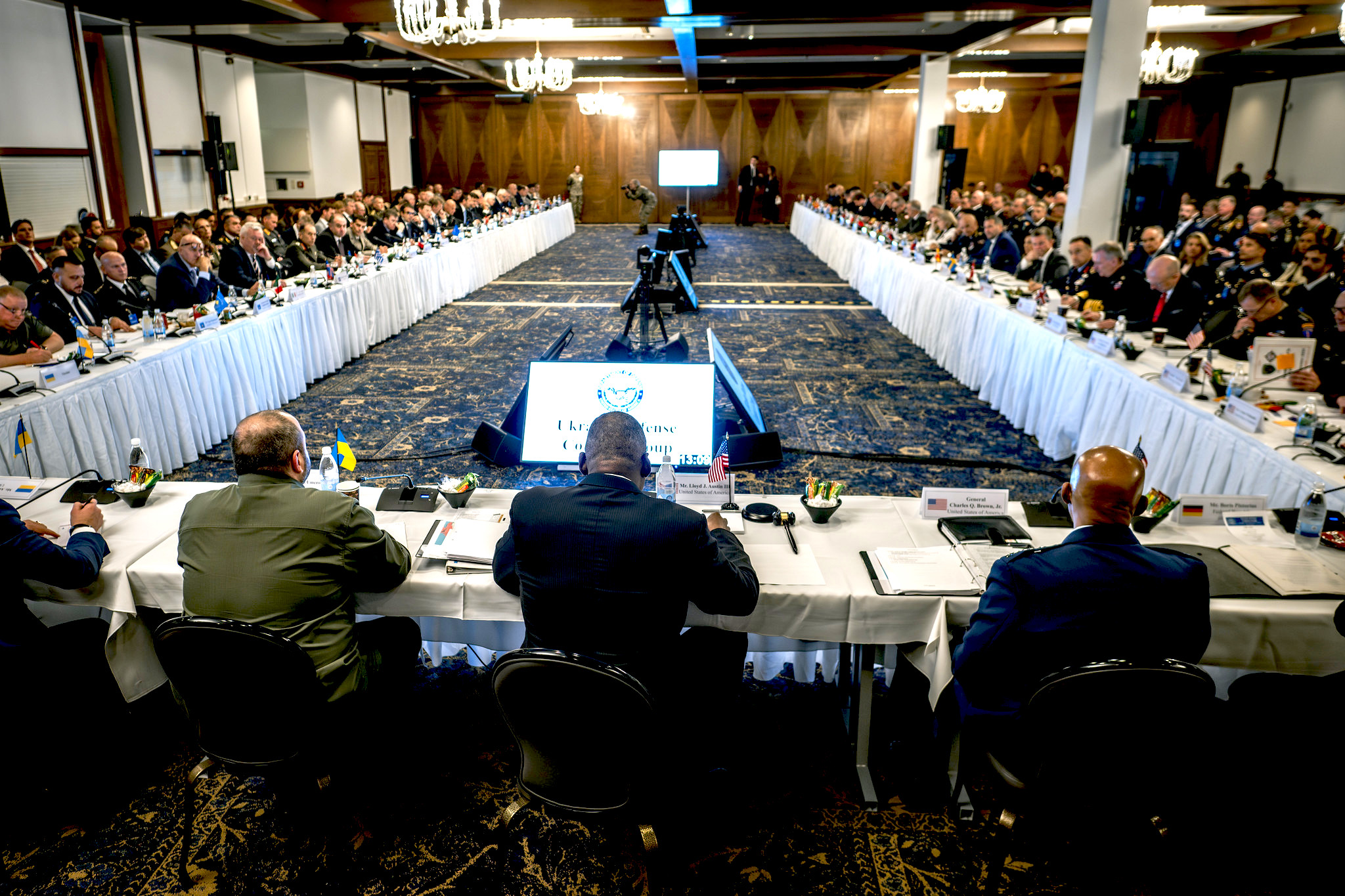
U.S. Secretary of Defense Lloyd Austin and chairman of the Joint Chiefs of Staff, Gen. CQ Brown, host the 24th meeting of the Ukraine Defense Contact Group at Ramstein Air Base, Germany on Sept. 9. (DoD/Chad J. McNeeley)
By Scott Ritter
SCOTT RITTER EXTRA
 If you’re not thinking about the end of the world by now, you’re either braindead or stuck in some remote corner of the world, totally removed from access to news.
If you’re not thinking about the end of the world by now, you’re either braindead or stuck in some remote corner of the world, totally removed from access to news.
Earlier this month we came closer to a nuclear conflict between the U.S. and Russia than at any time since the Cuban Missile Crisis of 1962.
[See: SCOTT RITTER: 72 Minutes]
Today we are even closer.
Most scenarios being bandied about in the Western mainstream media that involve a nuclear conflict between Russia and the United States have Russia initiating the exchange by using nuclear weapons against Ukraine in response to deteriorating military, economic, and/or political conditions brought on by the U.S. and NATO successfully leveraging Ukraine as a proxy to achieve the strategic defeat of Russia.
Understand, this is what both Ukraine and the Biden administration mean when they speak of Ukraine “winning the war.”
This is a continuation of the policy objective set forth by Secretary of Defense Lloyd Austin in April 2022, “to see Russia weakened to the degree that it can’t do the kinds of things that it has done in invading Ukraine,” meaning that Russia should “not have the capability to very quickly reproduce” the forces and equipment that it loses in Ukraine.
This policy has failed; Russia has absorbed four new territories — Kherson, Zaporizhia, Donetsk and Lugansk — into the Russian Federation, and the Russian defense industry has not only replaced losses sustained in the Ukrainian conflict, but is currently arming and equipping an additional 600,000 troops who have been added to the Russian military since February 2022.
It is the United States and its NATO allies that find themselves on their back feet, with Europe facing economic hardship as a result of the extreme blowback that has transpired because of its sanctioning of Russian energy, and the United States watching helplessly as Russia, together with China, turns the once passive BRICS economic forum into a geopolitical juggernaut capable of challenging and surpassing the U.S.-led G7 as the world’s most influential non-governmental organization,

Scott will discuss this article and answer audience questions on Episode 198 of Ask the Inspector. Call us during the show at 520.525.8359, or click here to submit your question in advance.
Illusionary Red Lines
As a result of this abysmal failure, policymakers in both the U.S. and Europe are undertaking increasingly brazen acts of escalation designed to bring Russia to the breaking point, all premised on the assumption that all “red lines” established by Russia regarding escalation are illusionary — Russia, they believe, is bluffing.
And if Russia is not bluffing?
Then, the Western-generated scenario paints an apocalyptic picture which has a weak, defeated Russia using nuclear weapons against Ukraine in a last, desperate act of vengeance.
According to this scenario, which the U.S. and NATO not only war-gamed out but made ready to implement when these entities imagined that Russia was preparing to employ nuclear weapons back in late 2022-early 2023, the U.S. and NATO would launch a devastating response against Russian targets deep inside Russia designed to punitively degrade Russian command and control, logistics, and warfighting capacity.
This would be done using conventional weapons.
If Russia opted to retaliate against NATO targets, then the U.S. would have to make a decision — continue to climb the escalation ladder, matching Russia punch for punch until one side became exhausted, or preemptively using nuclear weapons as a means of escalating to de-escalate — launch a limited nuclear strike using low-yield nuclear weapons in hopes that Russia would back down out of fear of what would come next — a general nuclear war.
The Pentagon has integrated such a scenario into the range of nuclear pre-emption options available to the president of the United States. Indeed, in early 2020 U.S. Strategic Command conducted an exercise where the secretary of defense gave the launch instructions for a U.S. Ohio class submarine to launch a Trident missile carrying W-76-2 low yield nuclear warheads against a Russian target in a scenario involving Russian aggression against the Baltics in which Russia used a tactical nuclear weapon to strike a NATO target.
The insanity of this scenario is that it ignores published Russian nuclear doctrine, which holds that Russia will respond with the full power of its strategic nuclear arsenal in the case of a nuclear attack against Russian soil.
Once again, U.S. nuclear war planners believe that Russia is bluffing.
Another Twist
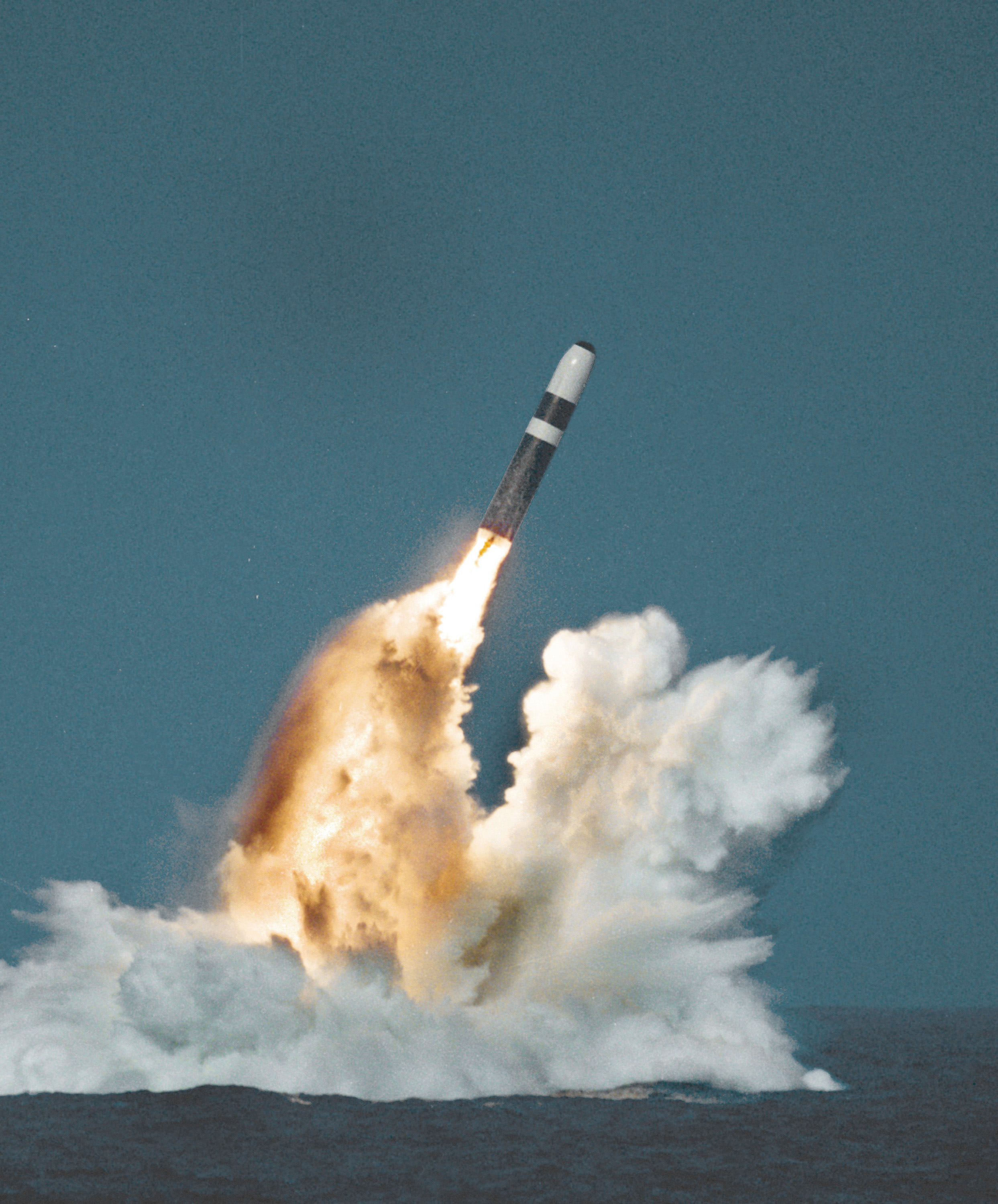
Submarine launch of a Lockheed Trident missile. (DoD, Wikimedia Commons, Public domain)
There is another twist to this discussion.
While the U.S. might assess that Russia would not seek a general nuclear war following the use by the U.S. of low yield nuclear warheads, the problem is that the means of employment of the W-76-2 warhead is the Trident submarine launched ballistic missile.
While the February 2020 scenario had Russia using nuclear weapons first (something which, at the time, represented a gross deviation from published Russian nuclear doctrine and the declaratory policy statements of the Russian president), the fact is the U.S. will not necessarily wait for Russia to kick things off on the nuclear front.
The United States has long embraced a nuclear posture which not only incorporates the potential of a nuclear first strike, but, through declaratory policy statements, actively encourages America’s potential nuclear adversaries to believe such an action is, in fact, possible.
David J. Trachtenberg, the deputy undersecretary of defense for policy during the Trump administration, said in a speech at the Brookings Institution in 2019 that a key aspect to the U.S. nuclear posture was “keeping adversaries such as Russia and China guessing whether the U.S. would ever employ its nuclear weapons.”
But the U.S. takes the guesswork out of the equation. Theodore Postol points out, in a recent article in Responsible Statecraft, that a new fuse used on the W-76 nuclear warhead (not the low yield W-76-2, but rather the 100 kiloton version) has turned the 890 W-76 warheads loaded on the Trident missiles carried onboard the Ohio-class ballistic missile submarines into weapons capable of destroying hardened Russian and Chinese missile silos with a single warhead.
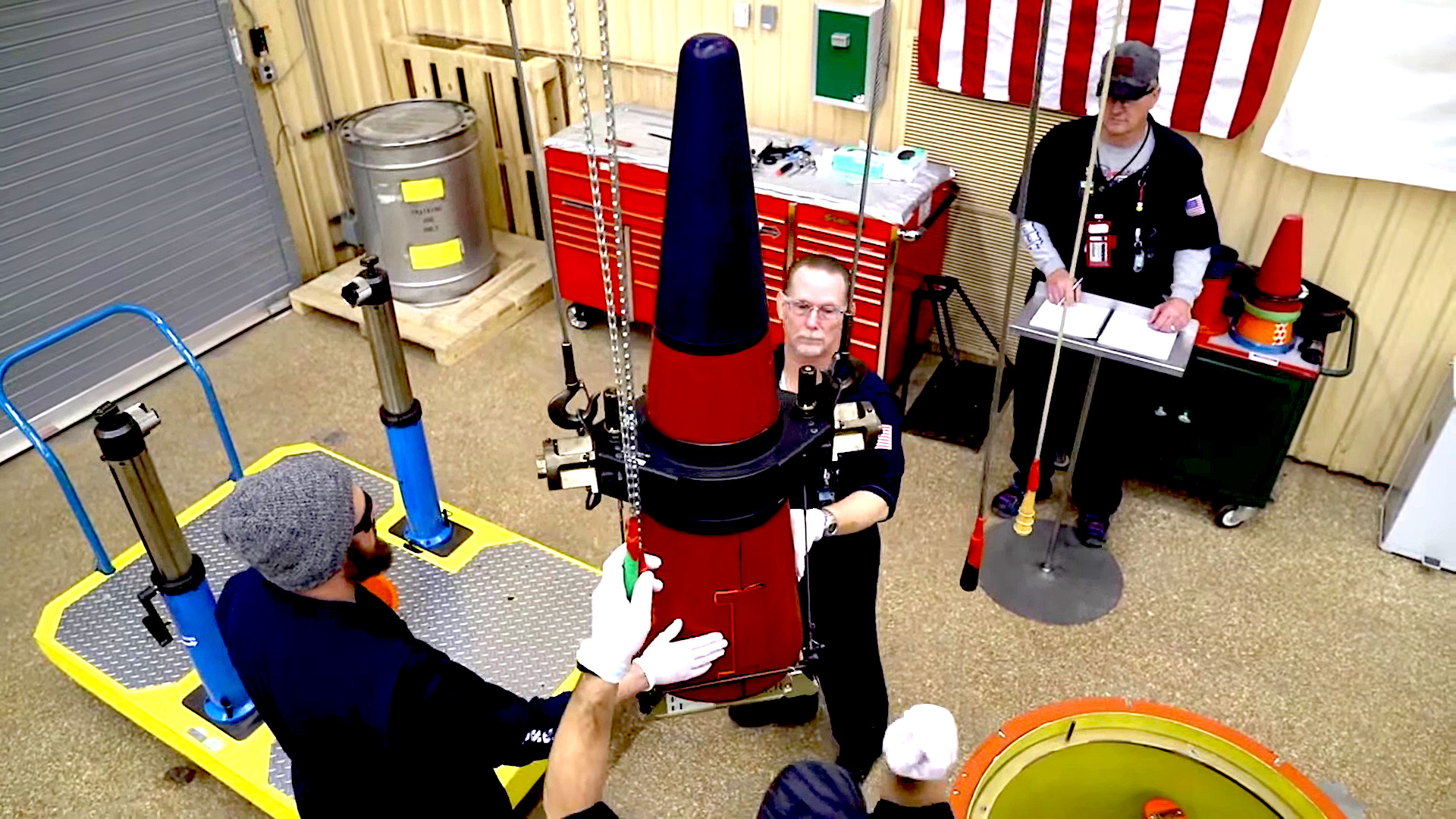
Screenshot of a National Nuclear Security Administration video from 2019 showing the casing of a W-76-1 thermonuclear warhead. (National Nuclear Security Administration, Wikimedia Commons, Public domain)
This means that, firing in a reduced trajectory profile from a position close to the shores of either Russia or China, the United States possesses the ability to launch a nuclear first strike that has a good chance of knocking out the entire ground-based component of both the Chinese and Russian strategic nuclear deterrent.
As a result, Russia has been compelled to embrace a “launch on detect” nuclear posture where it would employ the totality of its silo-based arsenal the moment it detected any potential first strike by the United States.
Return, for a moment, to the scenario-driven employment of the W-76-2 low-yield nuclear weapon as part of the “escalate to de-escalate” strategy that underpins the entire reason for the W-76-2 weapon to exist in the first place.
When the United States launches the Trident missile carrying the low yield warhead, how are the Russians supposed to interpret this act?
The fact is, if the U.S. ever fires a W-76-2 warhead using a Trident missile, the Russians will assess this action as the initiation of a nuclear first strike and order the launching of its own nuclear arsenal in response.
All because the United States has embraced a policy of “first strike ambiguity” designed to keep the Russians and Chinese guessing about American nuclear intentions.
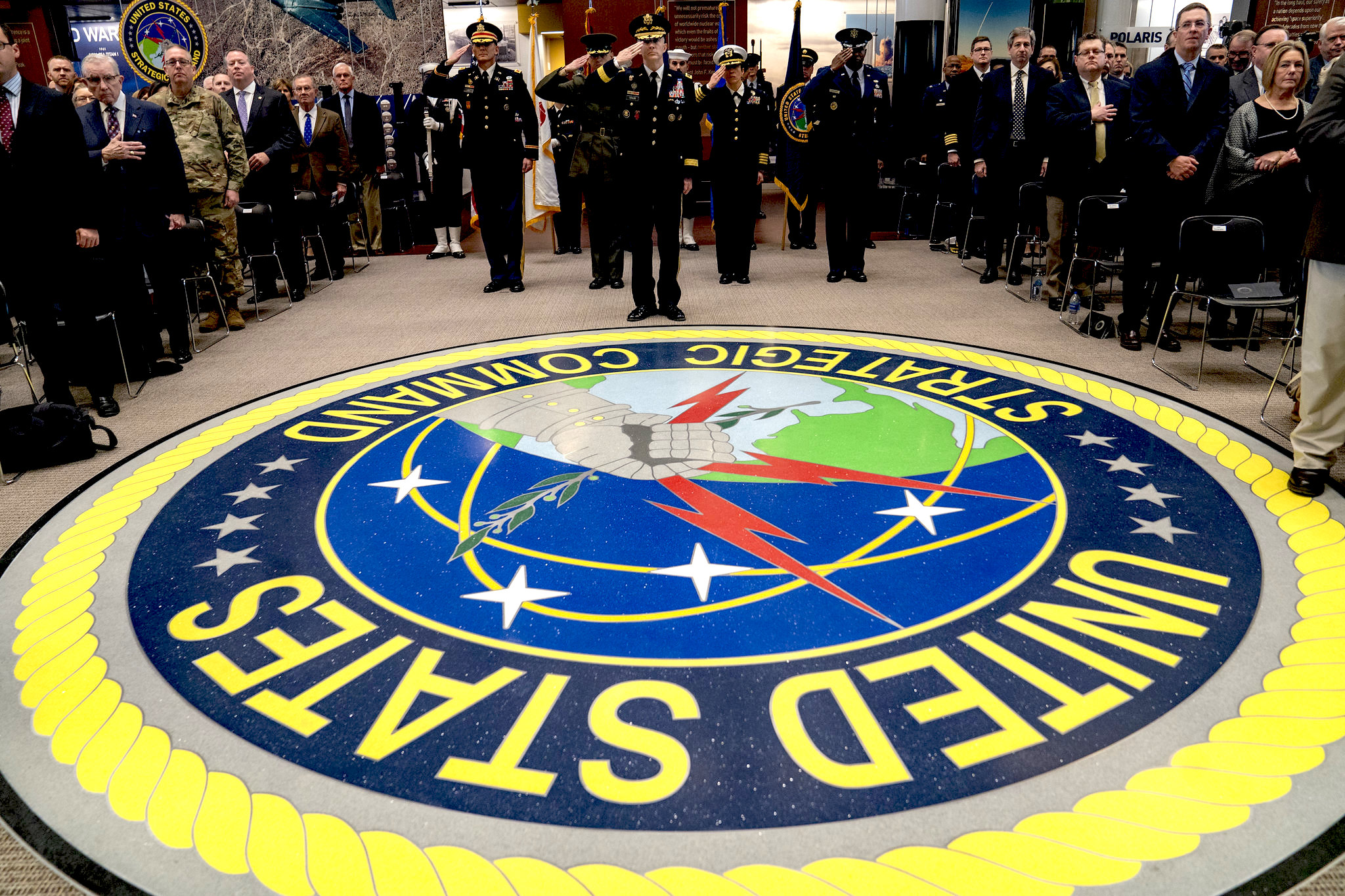
Change-of-command ceremony in November 2019 at Offutt Air Force Base in Nebraska for U.S. Strategic Command, which has responsibilities that include strategic deterrence and nuclear operations, including NC3 – command, control and communications. (DOD/Dominique A. Pineiro)
And, to put icing on this nuclear cake, Russia’s response appears to have been to change its nuclear posture to embrace a similar posture of nuclear pre-emption, meaning that rather than wait for the U.S. to actually launch a nuclear-armed missile or missiles against a Russian target, Russia will now seek to pre-empt such an attack by launching its own pre-emptive nuclear strike designed to eliminate the U.S. land-based nuclear deterrent force.
In a sane world, both sides would recognize the inherent dangers of such a forward-leaning posture, and take corrective action.
But we no longer live in a sane world.
Moreover, given the fact that the underlying principle guiding U.S. policies toward Russia is the misplaced notion that Russia is bluffing, any aggressive posturing we might engage in designed to promote and exploit the ambiguity derived from the first-strike potential inherent in existing U.S. nuclear posture will, more likely than not, only fuel Russian paranoia about a potential U.S. nuclear pre-emption, prompting Russia to pre-empt.
Russia isn’t bluffing.
And our refusal to acknowledge this has embarked us on a path where we appear more than willing to pre-empt life itself.
We need to pre-empt nuclear preemption by embracing a policy of strict no- first-use principles.
By choosing deterrence over warfighting.
By deemphasizing nuclear war.
By controlling nuclear weapons through verifiable arms control treaties.
And by eliminating nuclear weapons.
It truly is an existential choice — nuclear weapons or life.
Because they are incompatible with one another.
The author will be speaking on the danger of nuclear war and the need for policies that seek to avoid confrontation between the United States and Russia at the Peace & Freedom Rally tomorrow, Saturday, Sept. 28, in Kingston, New York.
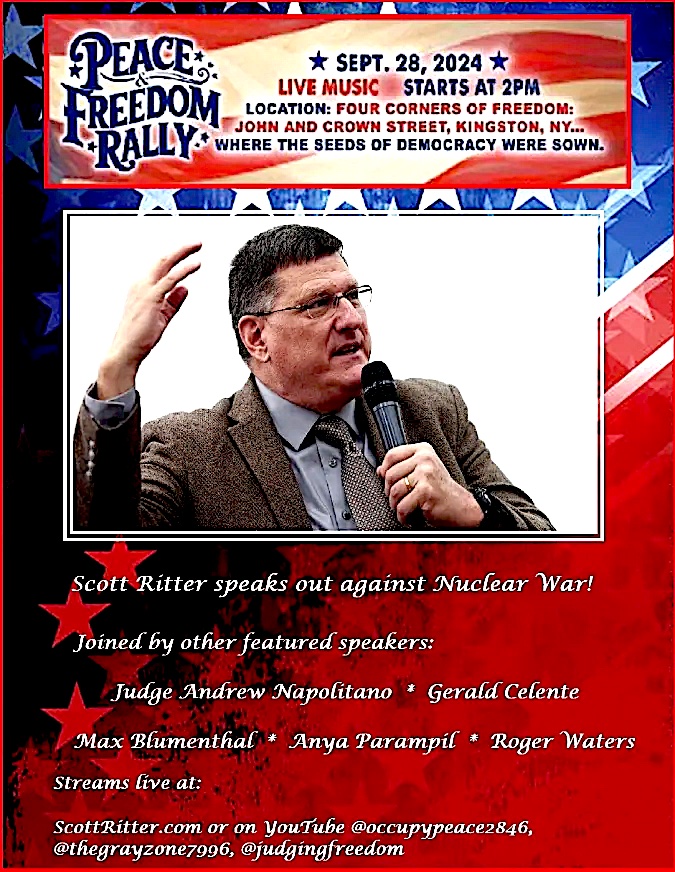
Scott Ritter is a former U.S. Marine Corps intelligence officer who served in the former Soviet Union implementing arms control treaties, in the Persian Gulf during Operation Desert Storm and in Iraq overseeing the disarmament of WMD. His most recent book is Disarmament in the Time of Perestroika, published by Clarity Press.
This article is from the author’s Substack, SCOTT RITTER EXTRA.
The views expressed are solely those of the author and may or may not reflect those of Consortium News.
Please Donate Today to CN’s Fall Fund Drive



This has been pointed out by a lot of people, but it never ceases to blow my mind: that the ruling class would escalate to such a degree when THEY are the ones with the most to lose in terms of worldly power and possessions. If we have a wide scale nuclear war, capitalism itself will be beheaded. All the ports, the centers of government, the factories, etc., etc., will be obliterated. Nuclear winter and massive radioactive fallout will ensue. Are these people on top of the pyramid insane enough to kill their own God? It’s a false God, of course, but you see my point. The irony is so thick it’s almost enough to make you laugh hysterically. Poor people or working-class poor people on the street, we have nothing to lose save our health and lives. The ruling class, in lieu of nuclear war, will be reduced to paupers. They will lose EVERYTHING that’s so, so important to them and all the things that make them so much better–in their hubristic eyes–than the rest of us. You’d think this would be sufficient to drive them to the negotiating table, but no. For the life of me, I can’t understand it. The truly terrifying part is apparently THEY can’t understand it, either. God help us all.
And we would all die because the Globalist “rules based order” wants what Lindsey Graham has already admitted. The 11 Trillion + in natural resources in Eastern Ukraine. To float a dying neoliberal system already in a crisis of over-accumulation. That is the rich have too much money, and labor doesn’t have enough work (over-accumulation of labor)
The worlds population is at risk of death precisely to the extent the globalist-neoliberal-neoconservatives want of even more money.
Let the neoliberal capitalist system die rather than the people. Let another system take it’s place.
Coming from a sort of military family, and having served myself, I have some hope the militaries have better sense than to go nuclear; this type of war will kill everybody and leave no winners. Sclerotic governments, ours especially, doesn’t seem capable of understanding this basic fact.
I am encouraged that President Biden is obviously not calling the shots, so, whoever is may have more diplomatic interests and abilities.
Bushrod Lake….Biden’s ear is most likely filled with the withered breath of Antony Blinken, the not diplomatic diplomat with a seemingly indelible Zionist streak….leading him to lie before Congress…resulting in less humanitarian aid to Palestinians….you can google that travesty….Blinken lies to Congress….
It really is shocking (to me) to see so many high level people in the West so casually dismiss the possibility of nuclear war while encouraging NATO to escalate the war in Russia. Losing the war in Ukraine seems to have transformed Western leaders into childlike creatures devoid of logic and common sense, letting emotion take over decisions involving life and death. Worrisome, indeed.
Here’s something that is germane to this discussion:
hxxps://youtu.be/B-fSZFWxWZc
With all the talk these days about nuclear armageddon I’d feel a lot safer if Russia, China, and their allies built effective anti-missile defenses and sufficient hypersonic delivery vehicles with HE non-nuclear warheads to destroy most of the West’s nuclear delivery capability before it could be used by the Western crazies to potentially destroy the world. Of course depending upon such external saviors is hardly fair when we really ought to be handling the problem of our own insane leaders ourselves.
To quote the opening sentence”. “..Policymakers in both the U.S. and Europe are undertaking increasingly brazen acts of escalation in Ukraine designed to bring Russia to the breaking point….”
Little do the policy makers of both the U.S. and Europe realise that Russia has already brought Ukraine to the breaking point and has a more than brazen capacity to respond directly to both U.S.A. and Europe if their provocations continue to escalate .
Sounds to me like those tests of ultra high tech weapon guidance systems that performed as hyped only for sitting duck targets. Targets that were not merely sitting, but their equivalent feet, wings, and beaks also firmly taped shut. In other words, results believable only to people determined to see what they want to see despite overwhelming evidence to the contrary.
The logic here is to simply assume an outcome the neocon/neolib cabal most wants to see. Anything beyond the severely limited wavelengths of the neolib reality tunnel is invisible to them. Therefore by definition unsubstantial. What the vast majority of the world’s population might believe is of no concern. The ultimate might makes right; give them unipolar or give us death.
The escalation is bringing the western powers to the breaking point, not Russia. All of their plans have failed so far, and have largely backfired on them, making Russia stronger in the process.
I can just hear the gnashing of teeth in Washington, London and Brussels as they cook up yet more hair brained schemes to defeat Russia and topple Putin!
But in doing so, they become ever more desperate, reckless and dangerous, prepared to take more risks in the deluded belief that Russia is bluffing and would never launch nukes.
Until it does. Then they will have 72 minutes to regret their actions!
This is the true meaning of Russian Roulette.
The preemptive war against Iraq openly created this world. Both sides given a reason for first strike based on anything at all.
Not only that the western world has reason to think they may no longer be able to control world culture for their religious fiction and economic and military superior dominance without acting now before we are required to share the world with others on an equal footing. Our way of life based on taking unfair advantage of the rest of the world is imminently threatened requiring the insanity of preemptive warfare.
There is no god to save us from ourselves.
Not only are “we no longer live in a sane world,” we haven’t been living in a sane world for most of my lifetime.
The definition of sanity is whatever the majority of a population (or sub-population ) believes to be the ‘right and natural way’ be it Aztec sacrifice, the god given right of gun ownership or the evil of specific others; the primary conditions for true human sanity have long been replaced by baseless, though functional, beliefs.
The prevalence of the neocon “thought process” at the very pinnacle of US foreign policy is not a surprise. It is a continuation of the centuries old plan by the Zionist radicals. And the Zionist radicals are the Rothschilds and Rockefellers and their ilk who control all mass media, politics, and policy making in the West due to their stranglehold on international banking cartels who want neverending wars. These wars produce spoils such as endless natural resources that are available in counrries such as Ukraine and Russia if they can only “break up” these nations and control them using color revolutions, the corrupt IMF and World Bank institutions and targested assassinations by the CIA and various NGOs funded by the Rothschilds Rockefellers and other mad Zionists. Only through cooperation will Russia, China and the Global South in the form of BRICS force a retreat of the Zionists. And that is happening now. So much for MacKinder’s “Geopolitical Pivot of History” in the 19th century long after Napoleon and Europe failed to dominate Russia. It will never happen.
I think this would be a fine time to start talking about the 800 pound gorilla in the room – the Neocon / Zionist organization that has terrorized the US, Britain, and the UN into submission, and who is driving their two front war in Palestine and Ukraine in their deluded attempt to dominate the world, as per their Project for a New Israeli Century. It’s time to stop being “baffled” at the apparent irrationality and treason of Collective West political “leaders”. They are simply additional victims of Zionist terrorism. Nobody wants to meet the fate of JFK or the 100+ journalists who have been assassinated by Israel. That’s my opinion.
Well said, and quite accurate for sure, TDillon! They got the US involved in the first two world wars, and now the third?
I watched Joe Lauria’s interview with Scott Ritter and Gerald Celente yesterday and I recommend it. I hope they have much success at the Kingston Rally alerting people to the seriousness of a nuclear exchange as too many people are complacent and go along with the ruling-class who have subtly numbed their (critical) thinking abilities.
Excuse me for saying so, Frank, but you’re lambasting a tad, which you seem to be unaware of; talking of ‘critical thinking’ as per TDillon!
The Zionist organization was first founded in 1897, yet you seem already, to be blaming it alone, for getting “the US involved in the first two world wars”.
What of the ‘Great British Empire’, which demonstrated, through its centuries long actions of devastating the lands it settled as colonies; freely plundering and utterly decimating, for centuries, prior to the birth of the current hegemonic U.S. A., whilst all the while proclaiming itself to be the one Empire upon which the sun would never set.
At the close of WWI, it was, apparently still the tail wagging the dogs of war, by going forward with the Balfour Declaration (1917) and arbitraily dividing Palestine 78/22% in favor of the Hashemite dynasty of Saudi Arabs of the Hejaz region of the Arabian peninsula.
The now, more obviously declining U.S. Empire, is in the same shadow of the setting sun, the only difference being that the final actual existential Nuclear War is starkly showing its face of the truth on this threatening new horizon, to spoil its party!
Amen!
T, I agree. For those of us that remember the card game of “Hearts”, Israel has committed to winning this struggle by “Shooting the Moon”. While pretending to be a distressed victim, Israel is steadily playing their hand to settle all scores and establish a new kingdom in the world…with the support of all the western capitalist democracies. They would not be acting this way unless they were confident they had all the Hearts in their control.
What a genius plan!! What if another gang had been this subtle?
They are exploiting a critical weakness of all democracies…that most politicians can be bought (or blackmailed). In the lobby of our Capital, money is the trump card (no pun intended). The US gives Israel 3 billion a year… so Israel can bribe our elected representatives at no expense to themselves. AIPAC then doles out OUR TAX DOLLARS to the politicians that kiss the ass of Netanyahu!
WHAT FOOLS WE ARE! In one way or another we have all been baited by this malignant Golem. Even the Christians have been lead away from the teachings of their Prophet.
The Zionists have written, directed and produced this play. It stars the “Chosen People” as burgeoning masters of the planet. The Eastern Tolkien Hordlands are not so easily corrupted. They are the antagonist. They refuse to kiss the ring of the new master. How does it end? Will a new Samson bring the Temple down over all of us?
My opinion too!!
I guess all of the wealthy western oligarchs and their minions think they can just run to their bunkers for shelter. Well good luck with that because they will be living underground for the rest of their lives, the rest of their children’s lives and their children’s lives, ad nauseam…
Absolutely. During the Cold War (about 1946-1991) we had real statesmen (Averill Harriman, Henry Kissinger, etc.) who knew and articulated that no one could win a nuclear war, particularly one between Russia and the United States. Now Russia is teamed up with nuclear armed China, the biggest economy in the world. The Neocons, who have had so much influence on U.S. policy since George W. Bush’s presidency, are clearly nuts. They have gotten us into war after war. They act like some kind of death cult, which unconsciously wants to end the world. If the Neocons are permitted to continue in office, as they will in a Harris presidency, then our chances of world war will be very high. The Neocons also have an irrational hatred of Russia, one of their chief motivators. For world survival, I am voting for Trump, who is committed to trade, not world war. Yes, he is flawed. Who isn’t, but he is a great deal healthier than the lethal Neocons, who have grabbed control of the Democratic Party. I used to be a Democrat. No more. I want my children and grandchildren to have a life.
Xxxx://en.m.wikipedia.org/wiki/Letters_of_last_resort
Quite by accident i came across the above.
My curiousity then led me to this article, which to me reads as satire:
Xxxx://www.theatlantic.com/international/archive/2024/07/british-election-nuclear-weapons/678919/
The Atlantic wrote — “Following a landslide victory for the Labour Party,”
Labour got 35% of the vote. Non-duopoly parties got 45% of the vote. I guess that is one of the many things we aren’t supposed to know. It might give us ideas.
Like i said, satire. What a joke. And already the façade has fallen:
Xxxx://www.theguardian.com/politics/2024/sep/28/rosie-duffield-resigns-as-labour-mp-with-scathing-attack-on-keir-starmers-leadership
@Patrick Powers : “Labour got 35% of the vote”
Or more properly, Labour got 35% of those who voted.
On a low turnout, Labour’s share of the vote actually equates to just 20% of those registered to vote.
And only 19% of the electorate bothered to vote!
… and the use of nuclear weapons is even more dangerously possible in the Middle East.